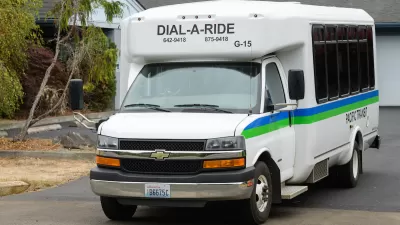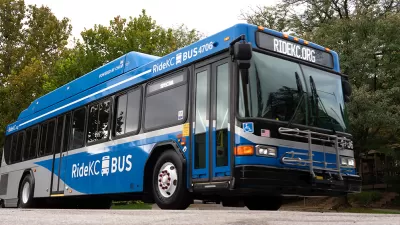The city’s costly experiment with on-demand transit is yielding to more strategic investment.

In 2016, Kansas City, Missouri became a pioneer in ‘microtransit,’ on-demand transportation services used to supplement or — in some cases — replace public transit.
In a piece for Bloomberg CityLab, David Zipper describes the city’s experiment and interviews Kansas City Area Transportation Authority CEO Frank White III, who says the original goal of introducing microtransit was to get more people to ride transit.
White admits that the public subsidy for the city’s current on-demand transit service is between $20 and $25 per passenger — roughly ten times as much as a fixed-bus route. But White asserts that “It works best in less dense areas. You could use it in rural areas where there is no fixed route service at all, or you could use it as a feeder system to nearby buses — but then the whole system has to be correlated, which can be challenging.”
For White, microtransit can also be a tool for gauging public interest in transit to pave the way for future fixed-route service and serving areas with no other options. “I think we’ll see more strategic use of microtransit, focusing on less dense areas and connecting with our fixed-route buses.”
FULL STORY: Kansas City Looks Back on its Long, Costly Ride With Microtransit

Alabama: Trump Terminates Settlements for Black Communities Harmed By Raw Sewage
Trump deemed the landmark civil rights agreement “illegal DEI and environmental justice policy.”

Planetizen Federal Action Tracker
A weekly monitor of how Trump’s orders and actions are impacting planners and planning in America.

Why Should We Subsidize Public Transportation?
Many public transit agencies face financial stress due to rising costs, declining fare revenue, and declining subsidies. Transit advocates must provide a strong business case for increasing public transit funding.

Understanding Road Diets
An explainer from Momentum highlights the advantages of reducing vehicle lanes in favor of more bike, transit, and pedestrian infrastructure.

New California Law Regulates Warehouse Pollution
A new law tightens building and emissions regulations for large distribution warehouses to mitigate air pollution and traffic in surrounding communities.

Phoenix Announces Opening Date for Light Rail Extension
The South Central extension will connect South Phoenix to downtown and other major hubs starting on June 7.
Urban Design for Planners 1: Software Tools
This six-course series explores essential urban design concepts using open source software and equips planners with the tools they need to participate fully in the urban design process.
Planning for Universal Design
Learn the tools for implementing Universal Design in planning regulations.
Caltrans
Smith Gee Studio
Institute for Housing and Urban Development Studies (IHS)
City of Grandview
Harvard GSD Executive Education
Toledo-Lucas County Plan Commissions
Salt Lake City
NYU Wagner Graduate School of Public Service





























